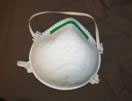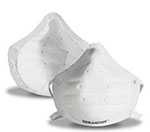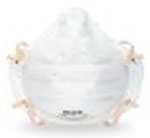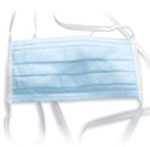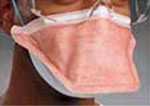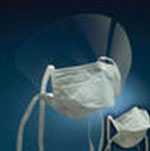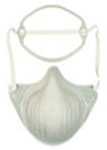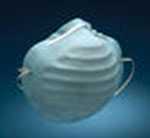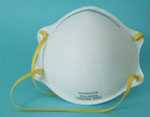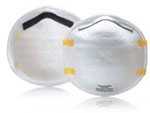Respirator Trusted-Source Information
Section 3: Ancillary Respirator Information
Is a surgical mask an N95 respirator?
No. Surgical masks are not designed for use as particulate respirators and do not provide as much respiratory protection as an N95 respirator. Surgical masks provide barrier protection against droplets including large respiratory particles. Most surgical masks do not effectively filter small particles from the air and do not prevent leakage around the edge of the mask when the user inhales.2 The NIOSH Science Blog: N95 Respirators and Surgical Masks, posted 10/15/2009, provides an explanation of the science behind and the similarities/differences between NIOSH-approved particulate respirators and surgical masks.
2 Reference: Rengasamy,S., B.C.Eimer, and R.E.Shaffer. (2009) Filtration performance of FDA-Cleared surgical masks. Journal International Society Respiratory Protection 26; 54-70.
OSHA Video: The Difference Between Respirators and Surgical Masks (scroll down page)
The Difference Between Respirators and Surgical Masks. U.S. Department of Labor Video, (2009, December 16). This video is available in English and Spanish and is available for downloading.
What is a surgical N95 respirator?
A surgical N95 respirator is a NIOSH-approved N95 respirator that has also been cleared by the Food and Drug Administration (FDA) as a surgical mask. These products are noted in bold font on the table of NIOSH-approved N95 respirators. For your convenience, view a comprehensive table of these products. If you have a product that you believe is FDA cleared that does not appear on this table, you should verify the FDA clearance by contacting the FDA at 1-800-638-2041.
The National Institute for Occupational Safety and Health (NIOSH) is the U.S. Government agency responsible for the certification and approval of respiratory protective devices for occupational use. The authority is granted to NIOSH in accordance with conditions and standards established in Title 42 of the Code of Federal Regulations (CFR), Part 84. It also addresses quality assurance requirements for the manufacturing of respiratory protective equipment. The approach to approval is that anybody can manufacture and sell any type of respiratory protective device, but only those that meet or exceed all of the requirements established in the 42 CFR Part 84 standards are acknowledged by NIOSH, and only those that have been NIOSH certified may be marketed as a NIOSH-approved respirator.
The FDA is the U.S. Government agency that oversees most medical products, foods, and cosmetics. Within the FDA, the Center for Devices and Radiological Health (CDRH) oversees the safety and effectiveness of medical devices. Medical devices intended for use in preventing and treating disease is subject to regulation under the device provisions of the Federal Food, Drug, and Cosmetic Act. This includes surgical masks and surgical N95 respirators. The FDA has no role in the approval or clearance of N95 respirators not intended for use as a medical device.
View a table of Surgical N95s which is provided as a courtesy. If you have a product that you believe is FDA cleared that does not appear on this table, you should verify the FDA clearance by contacting the FDA at 1-800-638-2041.
Can the products with an exhalation valve be used in healthcare?
Respirators with exhalation valves can be used in a healthcare setting when it is not important to maintain a sterile field (an example of an acceptable practice would be when taking the temperature or blood pressure of a patient). Respirators with exhalation valves should not be used in situations where a sterile field is required (e.g., during an invasive procedure in an operating or procedure room) because the exhalation valve allows unfiltered exhaled air to escape into the sterile field.
Do N95 respirators come in different sizes?
Yes. The sizing differs with each respirator model. Some of the sizing options include small, small/medium, medium, medium/large, and large. Particulate filtering facepiece respirators, including those commonly referred to as N95s, are available in multiple size configurations that are variable and not standardized across models.
How do I know what size I need?
Fit testing is needed to determine if a particular size and model of respirator provides you with an acceptable fit. Fit testing is model specific. Before you wear a respirator in an occupational setting, you must be fit tested in each respirator model you will wear.
Do N95 respirators come in different styles?
Yes. Filtering facepiece respirators are available in a wide range of colors, shapes, and styles. Some styles will fit individuals better than others and certain styles may be more comfortable and have better fitting characteristics. As long as the N95 is NIOSH-approved, has been fit tested, and is being used in accordance with the requirements of an OSHA-compliant respirator program, including appropriately donned by the user, then the wearer should receive the expected protection factor regardless of color, shape, or style.
Below are some of the styles available:
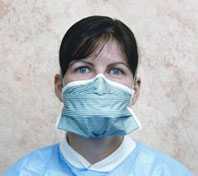
|
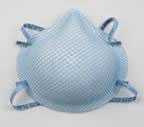
|
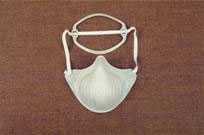
|
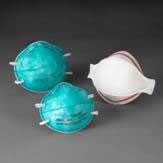
|
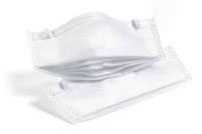
|
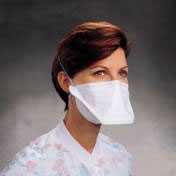
|
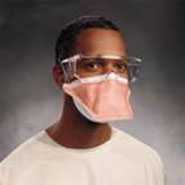
|

|
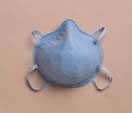 |
Photos courtesy of 3M, Kimberly-Clark, and Moldex.
Why do some N95 respirators have an exhalation valve on the front?
The use of an exhalation valve reduces exhalation resistance, which makes it easier to breathe (exhale). Some users feel that a respirator with an exhalation valve keeps the face cooler and reduces moisture build up inside the facepiece.
Does moisture build up in respirators?
The wearer’s respiratory secretions and moist exhaled breath can lead to moisture build-up in a respirator. While it is possible for moisture to build-up in a respirator with or without an exhalation valve, preliminary research shows that this is unlikely.
What are the differences among these products?
| Surgical, Medical, or Procedure Mask | N95 Respirator | Surgical N95 Respirator |
|---|---|---|
|
|
|
|
|
|
|
|
|
|
|
|
|
|
|
|
| Surgical, Medical, or Procedure Mask | N95 Respirator | Surgical N95 Respirator |
|---|---|---|
|
Evaluation, Testing, and Certification
|
||
| Filter efficiency, breathing resistance, fluid resistance and flammability data are reviewed by the FDA. Must demonstrate filtration efficiency no less than another surgical mask already cleared by the FDA (the minimum filtration level is unspecified). | Evaluated, tested, and certified by NIOSH as per the minimum performance requirements like filter efficiency and breathing resistance.
NIOSH approves nine filter classes of which N95 is the lowest. |
Evaluated, tested, and certified by NIOSH as per the minimum performance requirements as an N95 filtering facepiece respirator.
FDA accepts filter efficiency and breathing resistance based on NIOSH test results from the NIOSH approval evaluation, and reviews fluid resistance and flammability data submitted by the manufacturer for clearance of the N95 respirator as a medical device for use in a surgical setting. |
|
Intended Use
|
||
| A surgical mask is intended to prevent the release of potential contaminants from the user into their immediate environment. It is also used to protect the wearer from large droplets, sprays and splashes of bodily fluids. | Occupational (including medical) use. Reduces wearer’s exposure to particles including small particle aerosols and large droplets (all non-oil aerosols). | Can be used in any occupational setting where an N95 respirator is appropriate. Medical use where a sterile field needs to be maintained. Reduces wearer’s exposure to certain airborne particles (all non-oil aerosols) and provides a barrier to splashes and sprays. |
| Purpose | ||
| Barrier to splash, droplets, and spit. | Protects from exposure to airborne particles. In a healthcare setting, protects from exposure to biological aerosols including viruses and bacteria. | Protects from exposure to airborne particles and barrier to splashes, droplets, and sprays. In a healthcare setting, protects from exposure to biohazards including viruses and bacteria. |
| Face Seal Fit | ||
| Not designed to fit tight to face. | Designed to fit tight to face creating a seal around the perimeter of the respirator to improve protection. | Designed to fit tight to face creating a seal around the perimeter of the respirator to improve protection. |
| User Seal Check Requirement | ||
| Not designed for seal check. | Required each time a respirator is donned. | Required each time a respirator is donned. |
| Filtration | ||
| Does not effectively filter small particles from air. | Effectively filters large and small particles from air. | Effectively filters large and small particles from air. |
| Leakage | ||
| Leakage occurs around the edge of the mask when the user inhales. | When properly fitted and donned, minimal leakage around edges of the respirator when the user inhales. | When properly fitted and donned, minimal leakage around edges of the respirator when the user inhales. |
| Use Limitations | ||
| One time use (one patient encounter). | Single use. Should be discarded when it becomes damaged or deformed; no longer forms an effective seal to the face; becomes wet or visibly dirty; breathing through it becomes more difficult; or if it becomes contaminated with blood, respiratory or nasal secretions, or other bodily fluids from patients. | Single use. Should be discarded when it becomes damaged or deformed; no longer forms an effective seal to the face; becomes wet or visibly dirty; breathing through it becomes more difficult; or if it becomes contaminated with blood, respiratory or nasal secretions, or other bodily fluids from patients. |
| Available sizes | ||
| Generally only one size. | Available in multiple size configurations. However, sizing is not standardized among approved models. Some of the sizing options include small, small/medium, medium, medium/large, and large. | Available in multiple size configurations. However, sizing is not standardized among approved models. Some of the sizing options include small, small/medium, medium, medium/large, and large. |
How long can you wear the same N95 respirator?
The current NIOSH service-time-limit recommendations for non-powered particulate filter respirators are that filter elements should be replaced at the following frequencies:
- The service life of all filters on NIOSH-approved respirators is limited by considerations of hygiene, damage, and breathing resistance. All filters should be replaced whenever they are damaged, soiled, or causing noticeably increased breathing resistance.
- N-series filters generally should be used and reused subject only to considerations of hygiene, damage, and increased breathing resistance. However, for dirty workplaces that could result in high filter loading (i.e., 200 mg), service time for N-series filters should only be extended beyond eight hours of use (continuous or intermittent) by performing an evaluation in specific workplace settings that demonstrates: (a) that extended use will not degrade the filter efficiency below the efficiency level specified in 42 CFR 84, or (b) that the total mass loading of the filter(s) is less than 200 mg. These determinations would need to be repeated whenever conditions change or modifications are made to processes that could change the type of particulate generated in the user’s facility.
- For healthcare applications where use is for protection against confirmed or suspected 2009 H1N1 influenza, please refer to: Interim Guidance on Infection Control Measures for 2009 H1N1 Influenza in Healthcare Settings, Including Protection of Healthcare Personnel.
- For more information, please see the NIOSH Guidance on Extended use and Reuse of N95 Respirators.
Can an N95 respirator be used from Operating Room (OR) case to OR case or from patient to patient?
Used respirators are considered contaminated and ideally should be discarded after each patient encounter. Disposable N95 respirators worn during aerosol-generating procedures should be discarded after the procedure.
Healthcare facilities can extend the use of disposable N95 respirators by training personnel to wear them during serial patient encounters without removing or re-donning between encounters. There is the risk of respirator contamination and contact transmission with this practice where extended use of disposable N95 respirators could entail a risk of contact transmission by touching a contaminated surface of the respirator and subsequently touching the mucous membranes of the face or a hypothetical risk of re-aerosolization of virus from a used respirator. The risk will be minimized if healthcare workers (HCWs) perform hand hygiene every time before and after touching the respirator.
For healthcare applications where use is for protection against confirmed or suspected 2009 H1N1, please refer to Interim Guidance on Infection Control Measures for 2009 H1N1 Influenza in Healthcare Settings, Including Protection of Healthcare Personnel and Questions & Answers Regarding Respiratory Protection for Infection Control Measures for 2009 H1N1 Influenza among Healthcare Personnel for recommendations for the duration of wear for protection against the 2009 H1N1 exposure hazards.
Are PAPRs approved for use in a sterile OR field?
Powered Air-Purifying Respiratory (PAPR) use in the Operating Room (OR) has not been recommended as there is a lack of scientific evidence to support safe usage of this type of device and the possible impact (contamination of wearer’s exhaled, unfiltered air) onto the sterile field. AORN’s recommended practice, due to the lack of evidence, is to use a fit tested NIOSH-approved N95 respirator. Scientific studies are currently under way and prudent practice suggests adherence to AORN guidance of N95 use until more evidence is available. Also, at this time the National Personal Protective Technology Laboratory (NPPTL) would like to encourage inquirers to seek further guidance from the PAPR manufacturer.
Is cross contamination a concern if I wear the same N95 from patient room to patient room?
Yes, especially if the respirator was worn in a room with any type of aerosol generating procedure, or if the patient is suspected of or confirmed with having the 2009 H1N1 virus. Although this practice has the potential benefit of providing respiratory protection with limited supplies of respirators, there is the risk of respirator contamination and contact transmission. Extended use (i.e., use without removing or re-donning between encounters) of disposable N95 respirators could entail a risk of contact transmission by touching a contaminated surface of the respirator and subsequently touching the mucous membranes of the face or a hypothetical risk of re-aerosolization of virus from a used respirator. The precise balance between risk of contact transmission and benefit of extended use is unknown, although the risk will be minimized if healthcare workers (HCWs) perform hand hygiene every time before and after touching the respirator. In general, wearing an N95 respirator over multiple encounters (while minimizing touching, removing, or re-donning between encounters) would be favored over re-use, as this strategy is expected to involve less touching of the respirator and therefore less risk of contact transmission. For healthcare applications where use is for protection against confirmed or suspected 2009 H1N1, please refer to Interim Guidance on Infection Control Measures for 2009 H1N1 Influenza in Healthcare Settings, Including Protection of Healthcare Personnel and Questions & Answers Regarding Respiratory Protection for Infection Control Measures for 2009 H1N1 Influenza among Healthcare Personnel for recommendations for the duration of wear for protection against the 2009 H1N1 exposure hazards.
Can I take an N95 respirator off between patients or Operating Room cases?
Used respirators are considered contaminated and ideally should be discarded after each patient encounter. A user should never touch the contaminated front of the respirator with his or her bare hands. Hands should always be washed after donning and doffing the respirator. Healthcare facilities implementing steps to extend the existing supply of disposable N95 respirators by training personnel to re-use them (i.e., removing and re-donning between patient encounters) should refer to Questions & Answers Regarding Respiratory Protection for Infection Control Measures for 2009 H1N1 Influenza among Healthcare Personnel for recommendations for the possible re-use of respirators between patient encounters when used for protection against the 2009 H1N1 exposure hazards.
How should I store my N95 between patient encounters, in a healthcare setting?
The manufacturers provide instructions for cleaning, sanitizing, repairing, inspecting, and storing their respirators. The respirators should be packed or stored so that the respirators do not become damaged or deformed. Never store disposable respirators in pockets, plastic bags, or other confined areas. Infectious material deposited on personal protective equipment may cause it to become a vehicle for direct or indirect transmission. In those situations, care is needed when removing and storing personal protective equipment to avoid contaminating skin, clothing, and mucous membranes. Remove the respirator and either hang it in a designated area or place it in a bag (consider labeling respirators with a user’s name before use to prevent reuse by another individual). In healthcare settings where the patients have confirmed or suspected 2009 H1N1 influenza, please refer to Questions & Answers Regarding Respiratory Protection for Infection Control Measures for 2009 H1N1 Influenza among Healthcare Personnel for recommendations for the possible storage of respirators between patient encounters when used for protection against the 2009 H1N1 exposure hazards.
Can I infect myself from the droplets that accumulate on the outside of the respirator?
Respirators protect by capturing particles with the filter of the N95 respirator. Some aerosols can pose a contact hazard for infection. The accumulation of particles on the external surface of the respirator may be an exposure hazard from contact with the filter, including becoming a fomite for infectious agents. Users should be cautious and follow appropriate procedures to avoid self-inoculation from contact with these surfaces. Hand hygiene and infection control practices should be followed before and after touching the outside of the respirator when it is used in the presence of infectious agents.
Do I need special training to wear an N95 or do I put it on and wear it like a surgical mask?
The NIOSH certification requires respirators to be put on, used, and maintained in accordance with the manufacturer instructions and a respiratory protection program that meets the requirements of the Occupational Safety and Health Administration (OSHA) respiratory protection standard (29 CFR 1910.134). Training for all users is a mandatory part of OSHA’s respirator program requirements. Training is usually done at the same time that fit testing takes place. The OSHA standard contains required training elements. The manufacturer instructions for donning and doffing for each brand and model may be model-specific and must be followed. These instructions are located in the User Instructions provided, on the box, or individual package of the respirators. The manufacturer’s instruction for donning (putting on) the respirator is also included in the information provided in the NIOSH listing for approved disposable respirators.
Can we use an N95 that has not been cleared by the FDA in a patient setting?
NIOSH-certified N95 respirators that have not been cleared by the FDA can be used for respiratory protection to reduce the exposures of healthcare personnel in a patient setting to hazardous particulates. These respirators have not been evaluated by FDA to determine whether they meet the fluid and flammability resistance as required for FDA clearance as medical devices. For this reason, they are not intended for use in exposure settings where the performance of a surgical mask to maintain a sterile field is required.
What does it mean if a respirator is approved by NIOSH and cleared by the FDA?
N95 respirators that are both certified by NIOSH and cleared by the FDA as medical devices for use by healthcare personnel are called “surgical N95 respirators.” As with all NIOSH-certified N95 respirators, these products have been evaluated by the NIOSH certification process and have demonstrated that they can filter out a minimum of 95% of airborne particles under worst case test conditions. These products have also been evaluated by the FDA to have demonstrated an acceptable level of fluid and flame resistance, which may be important in healthcare occupational settings, such as surgical suites. The FDA clearance process also requires that these products have labeling that is relevant to healthcare personnel, such as information about the presence of natural rubber latex.
Additional Resources for Healthcare
Healthcare Workers’ Respiratory Protection Training
Preparedness through Daily Practice: The Myths of Respiratory Protection in Healthcare
Respiratory Protection Education & Resources Webkit
Implementing Hospital Respiratory Protection Programs: Strategies from the Field
- Page last reviewed: October 17, 2017
- Page last updated: September 28, 2017
- Content source:
- National Institute for Occupational Safety and Health National Personal Protective Technology Laboratory


 ShareCompartir
ShareCompartir
